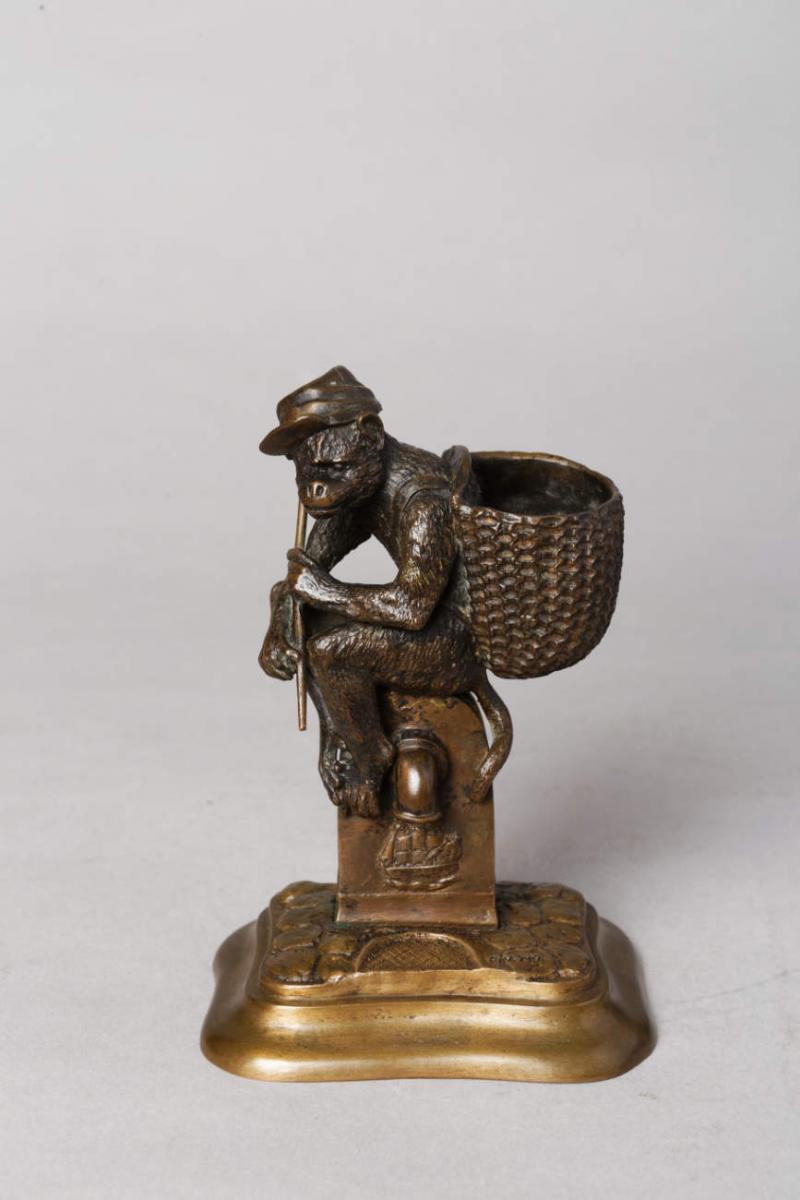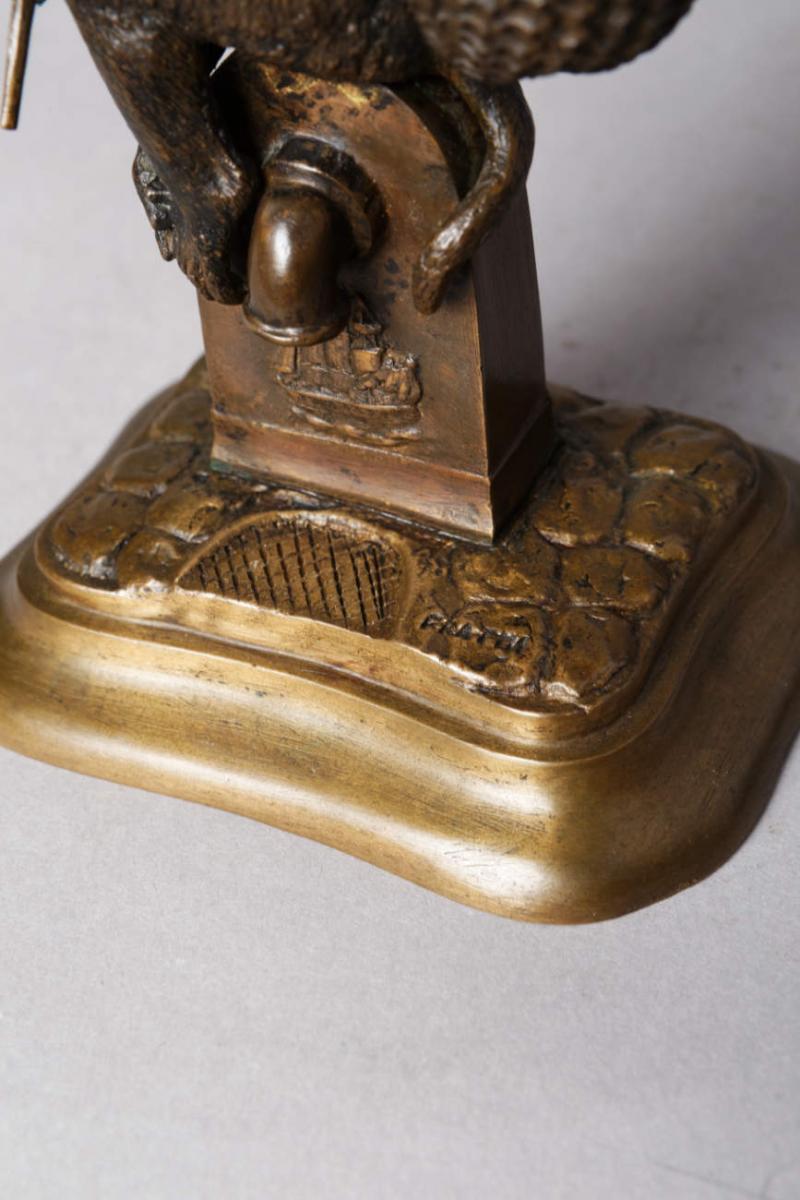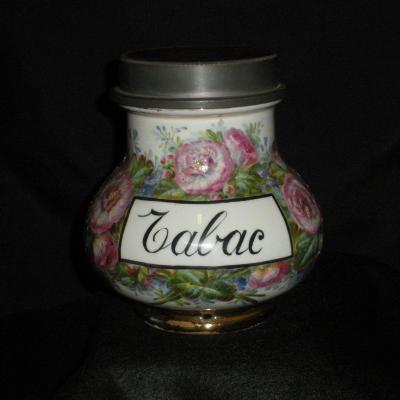France
mid-nineteenth century
Height 14,5 cm
link from our web catalog:
https://galerietourbillon.com/fratin-christophe-singe-porte-allumettes/
Tourbillon Gallery: Free Expertise - Buying - Sales
Biography
Christophe Fratin (1801-1864) exhibits from 1831 and regularly in the living room. During these Salons, he met Antoine-Louis Barye who imposed successively with the Tiger devouring a gharial in 1831, and his monumental lion snake of 1833, leaving, these two years, Fratin in the shadows. He ends up meeting with success and esteem: the critics are laudatory, his works are selling well. The repeated successes of the sculptor at the Salons of 1834, 1835 and 1836 aroused the interest of the aristocracy. Thus he works at the castle of Dampierre for the Duc de Luynes, where he realizes the Lions of the pediment of the main building and major interior decoration work. Fratin, who excels in the production of decorative objects, will provide four small pieces for the realization of a princely table, of which Barye is the main craftsman. Fratin's audience quickly became international, he moved to England between 1833 and 1834.
The artist also produced large romantic groups in Germany, Potsdam to the Sans-Souci and Babelsberg castles where some are still preserved. Throughout his career, the interest of the English clientele will not be denied. This tireless worker will even export his works to St. Petersburg where they decorated the park of the Russian Emperor. Romanticism is evident in his subjects, where the horse holds an important place.
The critics are numerous and often eulogistic, they present Fratin as the "formidable rival" of Barye in the representation of animals. These same critics emphasize his eagerness to create models and his ability to provide large works. The works are exhibited at the Maison Susse, which was holding a Passage des Panoramas store in Paris, where they are then proposed in plaster. It was actually in 1835 that the first editions of Fratin's bronzes were started, mainly cast in the Quesnel workshops. Christophe Fratin was thus one of the first, if not the first, to embark on publishing sculpture. These bronzes are made by the technique of sand casting (which had been mastered by the founders of this time) and are made in varying sizes. These first years take place under the banner of success. He obtains public commissions from his hometown of Metz to which he offers two full-size dogs, the year of his marriage, June 25, 1836 with Marguerite Sophie Pioche, the daughter of his drawing teacher. In 1837, the Salon became hostile to the young romantic generation and the participation of Fratin is reduced to his broodmare. It does not show up the following year and during the 1840s, shipments to the Salons are refused, therefore orders begin to fail. The career of the artist seems to rock and financial difficulties, become preponderant. The sculptor focuses on publishing and the realization of small commercial models. This inflection in his career is reflected by the portrait of small dimensions, Fratin by himself, where the humor of the sculptor appears. The artist, hands in his pockets, is dressed in his studio suit and wearing a cap. His pockets swarm with small animals: monkeys, mastiffs, spaniels ...
In the years that followed, Fratin struggles to obtain public orders, such as the order of the Eagles, sold in 1853, placed on the Esplanade of Metz, or the order a pediment representing La Chasse in 1855, for the Visconti court of the Louvre palace then in full construction. Finally, in 1862, he made his last order by ministerial decision Goat and kid. He also exhibits at various exhibitions such as the Exhibition of the Society of Friends of the Arts in Bordeaux, the Universal Exhibition of Metz under the patronage of the Empress in 1861, or the World Exhibition of 1862 in London. In 1849, following major financial difficulties, Christophe Fratin organized in Paris the first public sale without reproduction rights of 450 of his models. In 1854, he organized his second sale, which consists mainly of bronze models with rights of reproduction, which means that Fratin renounced the exploitation of these works. Fratin prefers to offer his works in public auction rather than open shop like Antoine-Louis Barye or Pierre-Jules Mêne. Christophe Fratin organized this type of sale every year until his death in 1864.
































 Le Magazine de PROANTIC
Le Magazine de PROANTIC TRÉSORS Magazine
TRÉSORS Magazine Rivista Artiquariato
Rivista Artiquariato